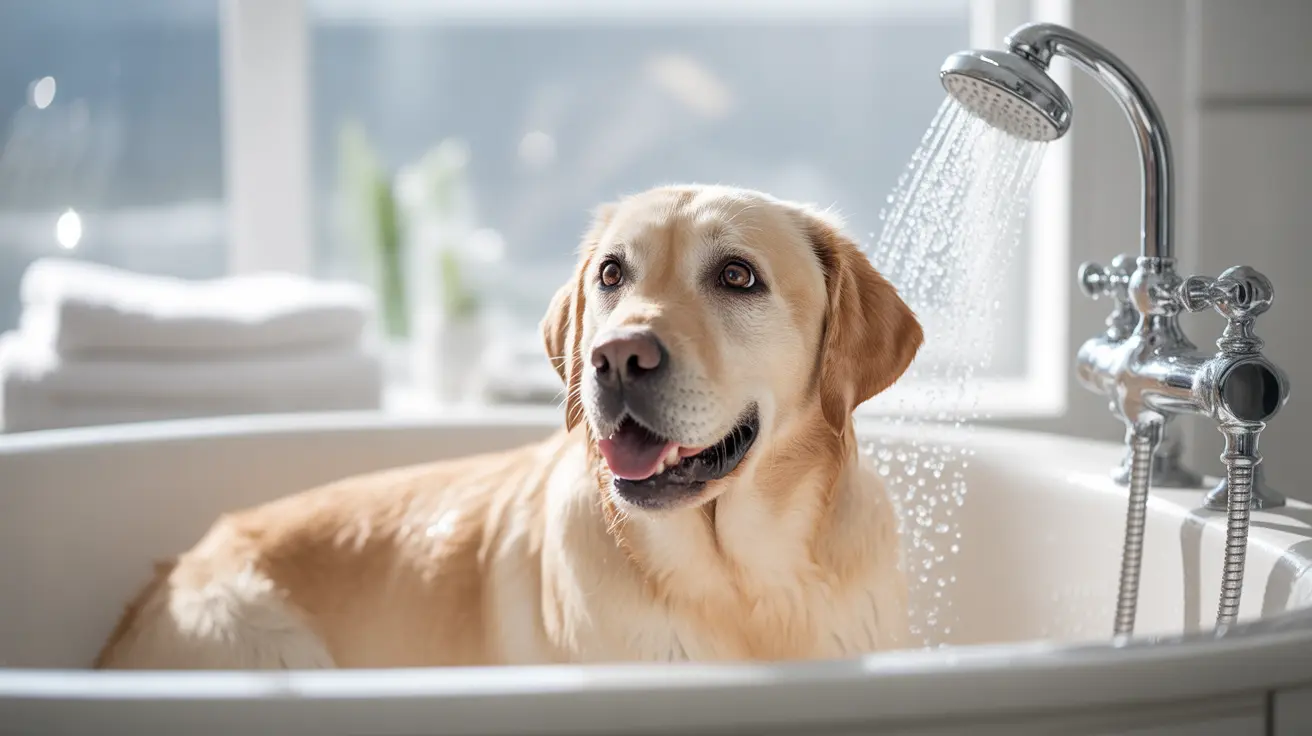How to Bathe a Dog Safely: A Complete Guide to Stress-Free Bathing
Bathing your dog safely requires more than just turning on the tap and applying shampoo. Many dog owners struggle with finding the right balance between keeping their pet clean and maintaining their skin health, while also ensuring the experience is stress-free for both dog and owner. Understanding how to bathe a dog safely involves knowing when bathing is necessary, choosing the right products, and following proper techniques that protect your dog's natural skin barrier.
The key to successful dog bathing lies in recognizing that dogs have different bathing needs than humans. Their skin has a different pH level, and excessive bathing can strip away essential natural oils that protect their skin and coat. This comprehensive guide will walk you through everything you need to know about safe dog bathing practices, from determining the right frequency to mastering the actual bathing process.
Understanding When Your Dog Actually Needs a Bath
One of the most important aspects of learning how to bathe a dog safely is understanding that not all dogs need frequent baths. The frequency of bathing depends on several crucial factors including breed, coat type, health conditions, lifestyle, and seasonal changes. There is no universal bathing rule that applies to all dogs, making it essential to assess your individual pet's needs.
Your dog likely needs a bath when they have a noticeable odor, visible dirt or mud on their coat, or if they're showing signs of itching or skin irritation. However, if your dog simply looks a bit dusty or has minor dirt on their fur, brushing might be a better alternative than a full bath. Regular brushing can effectively remove loose hair, dirt, and debris while distributing natural oils throughout the coat, often eliminating the need for frequent bathing.
Breed-Specific Bathing Requirements
Different breeds have vastly different bathing needs based on their coat characteristics. Double-coated breeds like Labradors and Huskies generally benefit from less frequent bathing to preserve their natural oils and maintain their coat's insulating properties. These breeds should typically be bathed every 8 to 12 weeks unless they've gotten particularly dirty or smelly.
In contrast, long-haired or curly-coated breeds may require bathing every 4 to 6 weeks alongside regular professional grooming to prevent matting and maintain coat health. Dogs with oily coats or those prone to odors might need baths every 2 to 4 weeks, while short-haired healthy indoor dogs may only need bathing every 8 to 12 weeks.
The Dangers of Over-Bathing and How to Avoid Them
Over-bathing is one of the most common mistakes dog owners make when trying to keep their pets clean. Excessive bathing can strip away your dog's natural skin oils, leading to dryness, irritation, and potentially more serious skin problems. Dogs' skin has a natural pH balance that differs from humans, and frequent washing disrupts this delicate balance.
When dogs are bathed too frequently, their skin may become dry and flaky, leading to excessive scratching and potential secondary infections. The natural oils in a dog's coat serve as a protective barrier against environmental irritants and help maintain healthy skin. Removing these oils too often forces the skin to work overtime to replenish them, which can result in an overproduction of oils, creating a greasy coat that seems to require even more frequent bathing.
Special Considerations for Puppies
Puppies require special attention when it comes to bathing frequency and technique. Young puppies should not be bathed frequently because their protective skin layer is not fully developed. Their delicate skin is more susceptible to irritation and temperature changes. If a puppy absolutely needs cleaning, spot cleaning with a damp cloth or specialized puppy wipes is often preferable to a full bath.
Choosing the Right Dog Shampoo and Products
Selecting appropriate bathing products is crucial for learning how to bathe a dog safely. Never use human shampoo on your dog, as it has a different pH level that can disrupt your pet's skin balance and cause irritation. Always opt for mild, dog-specific shampoos that are formulated for your pet's skin type and any specific conditions they may have.
For dogs with normal, healthy skin, a gentle, pH-balanced dog shampoo is ideal. If your dog has dry skin, oatmeal-based shampoos can provide soothing relief and moisturizing benefits. Dogs with specific health conditions may require medicated shampoos as prescribed by a veterinarian, sometimes requiring baths as often as weekly under professional guidance.
Seasonal Product Considerations
Different seasons call for different bathing approaches and products. During warmer months, dogs may need more frequent baths due to increased outdoor activity, dirt exposure, and parasite activity. However, drier winter months typically require less frequent bathing and may benefit from moisturizing shampoos that help combat the drying effects of indoor heating and cold weather.
Step-by-Step Safe Bathing Technique
Learning how to bathe a dog safely involves following a systematic approach that prioritizes your pet's comfort and safety. Start by choosing an appropriate location for the bath, such as a bathtub or shower equipped with an anti-slip mat to prevent accidents. The non-slip surface is essential for helping your dog feel secure and preventing injuries from slipping.
Before bringing your dog to the bathing area, ensure the water temperature is lukewarm, approximately 28 to 30 degrees Celsius (82 to 86 degrees Fahrenheit). Water that's too hot can burn your dog's sensitive skin, while water that's too cold can cause stress and discomfort. Test the water temperature with your elbow or a thermometer to ensure it's comfortable.
The Washing Process
When you're ready to begin washing, start by wetting your dog's paws first to help them acclimate to the water gradually. Use gentle water pressure to avoid startling your pet. Work your way up the body, being particularly careful around the head and ears. Avoid getting the dog's head and ears too wet, as excess water in these areas can lead to infections or discomfort.
Apply a small amount of dog shampoo and work it into a lather, starting from the neck and working down to the tail. Use minimal shampoo on sensitive areas like the head and face. Be thorough but gentle, massaging the shampoo into the coat without scrubbing too vigorously, which could irritate the skin.
Rinsing and Drying
Proper rinsing is crucial for safe dog bathing. Carefully rinse all shampoo residues from your dog's coat, as leftover soap can cause skin irritation and itching. Pay special attention to areas where shampoo tends to linger, such as under the legs, around the collar area, and in longer fur. Continue rinsing until the water runs clear and you can't feel any slippery residue when running your hands through the coat.
After thorough rinsing, dry your dog immediately with a large, absorbent towel. Pat and squeeze the coat rather than rubbing vigorously, which can cause tangles and skin irritation. If you choose to use a hair dryer, keep it on a cool setting and maintain a safe distance from your dog's skin to prevent burns or overheating.
Managing Bath-Time Anxiety and Fear
Many dogs experience anxiety or fear around bath time, making it essential to know how to bathe a dog safely while managing their stress levels. If your dog fears bathing, proceed very slowly and use positive reinforcement techniques. Allow your dog to explore the bathing area when it's dry, and reward calm behavior with treats and praise.
Start by letting your dog get used to the water gradually. You might begin by simply letting them stand in the empty tub with treats, then progress to adding a small amount of water to their paws. Anti-slip mats are particularly important for anxious dogs, as they help provide stability and confidence.
Distraction and Comfort Techniques
Distraction techniques can be incredibly effective for anxious dogs. Consider using lick mats spread with peanut butter or other favorite treats that can stick to the tub wall, keeping your dog occupied during the bath. Speak in calm, reassuring tones throughout the process, and take breaks if your dog becomes overly stressed.
Some dogs benefit from having a favorite toy in the tub or playing soft music to create a calming atmosphere. Remember that building positive associations with bath time may take several sessions, so patience is key to long-term success.
Seasonal Bathing Considerations and Winter Care
Understanding seasonal bathing needs is an important part of knowing how to bathe a dog safely year-round. In winter, bathing should be minimized whenever possible. The combination of cold temperatures, dry indoor air, and reduced outdoor activity means dogs typically stay cleaner longer and their skin may be more prone to dryness.
During winter months, focus on regular brushing and spot cleaning rather than full baths unless absolutely necessary. If you must bathe your dog in winter, ensure they are completely dry before going outside, and consider using a moisturizing dog shampoo to combat the drying effects of indoor heating.
Summer Bathing Adjustments
Warmer months often require more frequent bathing due to increased outdoor activities, swimming, and exposure to dirt, pollen, and other allergens. However, even in summer, avoid over-bathing. Instead, supplement baths with regular brushing and spot cleaning using dog wipes or diluted shampoo sprays to keep your pet fresh between full baths.
Recognizing Signs of Skin Problems and When to Seek Help
Part of learning how to bathe a dog safely involves recognizing when bathing might be causing problems or when professional help is needed. Watch for signs of skin irritation such as excessive scratching, redness, dry patches, or unusual odors that persist after bathing. These symptoms could indicate an allergic reaction to bathing products, over-bathing, or underlying skin conditions.
If your dog develops skin problems, consult your veterinarian for personalized advice. Some dogs may require special medicated shampoos or modified bathing schedules based on their individual health needs. Professional grooming may also be suitable for dogs that need frequent baths, special haircuts, or help managing mats and tangles.
Frequently Asked Questions
How often should I bathe my dog?
The frequency depends on your dog's breed, coat type, lifestyle, and health conditions. Generally, short-haired indoor dogs need baths every 8-12 weeks, while long-haired breeds may need bathing every 4-6 weeks. Dogs with oily coats or strong odors might need baths every 2-4 weeks, but avoid over-bathing as it can damage the natural skin barrier.
Can I use human shampoo on my dog?
No, never use human shampoo on your dog. Human shampoo has a different pH level that can disrupt your dog's skin balance and cause irritation. Always use mild, dog-specific shampoos that are formulated for your pet's skin type and any specific conditions they may have.
What water temperature should I use when bathing my dog?
Use lukewarm water at approximately 28 to 30 degrees Celsius (82 to 86 degrees Fahrenheit). Test the temperature with your elbow or a thermometer before bathing your dog. Water that's too hot can burn sensitive skin, while water that's too cold can cause stress and discomfort.
How can I help my dog overcome their fear of baths?
Proceed slowly and use positive reinforcement techniques. Start by letting your dog explore the dry bathing area with treats and praise. Gradually introduce small amounts of water, use anti-slip mats for stability, and consider distraction techniques like lick mats. Building positive associations takes time and patience.
Should I bathe my puppy?
Puppies should not be bathed frequently because their protective skin layer isn't fully developed. If a puppy needs cleaning, spot cleaning with a damp cloth or specialized puppy wipes is often preferable to a full bath. Their delicate skin is more susceptible to irritation and temperature changes.
What should I do if my dog's skin becomes irritated after bathing?
If you notice signs of skin irritation such as excessive scratching, redness, dry patches, or unusual odors after bathing, discontinue the current bathing products and consult your veterinarian. This could indicate an allergic reaction, over-bathing, or the need for specialized medicated shampoos.
Is it better to brush my dog instead of bathing them?
Regular brushing is often a better alternative to frequent bathing for removing dirt and maintaining coat health. Brushing distributes natural oils, removes loose hair and debris, and can eliminate the need for baths in many cases. However, when dogs are truly dirty or smelly, a proper bath is necessary.
Conclusion
Learning how to bathe a dog safely is about finding the right balance between cleanliness and maintaining your pet's natural skin health. Remember that less is often more when it comes to dog bathing – focus on bathing only when necessary, using appropriate products, and following gentle techniques that prioritize your dog's comfort and safety. Regular brushing, spot cleaning, and observing your dog's individual needs will help you develop an effective grooming routine.
By understanding your dog's specific breed requirements, using proper techniques, and being attentive to signs of stress or skin irritation, you can make bath time a positive experience for both you and your pet. When in doubt, consult with your veterinarian or a professional groomer who can provide personalized advice based on your dog's unique needs and health conditions.






